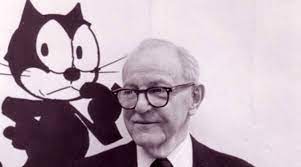Otto Messmer
Filed under: People, 1910s, 1920s, Early Sound, Felix the Cat, Noveltoons, Pat Sullivan Cartoons, Silent, U.S.A.,
 Full Name:
Full Name:Otto Messmer
Date of birth:16/08/1892
Date of death:28/08/1983
Birthplace:Union City, New Jersey
Biography
Messmer was a legendary American cartoonist and animator, who was best know as the creator of Felix the Cat, who is considered the first major cartoon star.
Family and early life
Messmer was born in West Hoboken, an enclave of German imigrants now known as Union City, New Jersey. Messmer’s parents John and Theckla Messmer worked in the West Hoboken silk mills. The Messmer family were a close knit, Roman Catholic home.
Messmer attended Holy Family, a parochial school in West Hoboken, where a Sister Rita helped him draw. The school had special drawing classes and held exhibitions for the public to view students’ work.
Messmer saw his first animated film, Winsor McCay’s Vaudeville act, in 1911 with his brother.
Career outline
For New York World and Life magazine, Messmer submitted some gag-cartoons which were published in 1914. While at school, Messmer experimented with animation with a character called Motor Mat, who had lots of crazy antics but still kept his cool.
That same year, while working at Universal, Messmer’s drawings were noticed by the artist Hy Mayer, a cartoonist turned animator. Mayer hired Messmer on to help him work on a series of animated commercials called The Travels with Teddy, and worked with Mayer again on a second series called Travelaughs, which featured travelogues animated with live-action footage.
Messmer’s work caught the attention of Pat Sullivan a year later, who hired him away to work at his studio in New York. With Sullivan, Messmer animated his first silent series, Sammie Johnsin (1916), and these films were released to theatres all over the country throughout the year. Sullivan and Messmer collaborated on many other projects as well, including Charlie Cartoons (1916), featuring an animated Charlie Chaplin playing the tramp character he was most known for. Messmer also released his own project Motor Mat and His Fliv, based on his Motor Mat character developed through his time at school which was distributed by Universal Pictures.
In 1917, Messmer created a comical two-reel animated short to accompany the release of the Universal Picture Twenty Thousand Leagues Under the Sea, also titled the same name.
In April 1917, Sullivan and Messmer had a falling out and subsequently, Messmer was draft into the Army to serve on the French Front in the first World War.
In 1919, Messmer and Sullivan reunited, post-war, to create the international sensation Felix the Cat, producing one cartoon a month. The black cat, who first appeared in Feline Follies, was distributed by Famous Players, and starred in more than 81 short theatrical cartoon animations until 1928. At the time, Messmer was competing with the Fleischer studio’s Out of the Inkwell series, as well as Paul Terry’s Aesop’s Fables, but Felix the Cat became the first merchandising phenomenon in the early silent animation era. The cat became famous through the merchandise, with his name engraved on key chains, a stuffed Cat version of Felix was sold, and later even comic books were published featuring the black cat.
Sullivan took credit for Felix the Cat throughout the years as publicly, Messmer was not acknowledged because Sullivan owned the rights to the character. As the silent cartoons were massively popular at the time, the duo never saw the reason to change it into a sound cartoon, even with the dawning of the new age of sound. Sullivan ended the series shortly after this period of popularity, and later died due to alcohol-related issues, despite having the intention of moving his studio to California to continue producing Felix the Cat cartoons.
Messmer freelanced for other studios after Sullivan’s death, such as at Van Beuren studios where in 1936 he oversaw the revival of three color theatrical cartoons, produced as a part of the Rainbow Parades series. Among these cartoons were Felix the Cat and the Goose That Laid the Golden Eggs, and Neptune Nonsense.
Additionally, Messmer freelanced at Famous Studios in the mid 40’s, storyboarding for cartoons such as Popeye, Little Lulu, and the Noveltoons cartoons.
Through later periods of his career, Messmer also pioneered the animated billboard, many of which were displayed in the lavish Time Square in New York, as well as developing the first animated television commercial in 1941.
In the 60’s, animator Joe Oriolo revived interest in Felix the Cat series by producing a new television series, sparking merchandise sales as well as the recognition of the cat’s real creator, Otto Messmer.
Messmer retired at the age of 80 in 1974, and numerous retrospectives were held in his work in Canada, US as well as in Europe, and a documentary about the man called Otto Messmer and Felix the Cat was produced in 1977 by an animation historian John Cannemaker.
Messmer passed away at the age of 91 due to a heart attack
Honors and awards
In 1979, Messmer was honored with the highest Winsor McCay Lifetime Achievement Award from the ASIFA organization.
References:
-
Lenburg, Jeff. Who’s Who in Animated Cartoons: An International Guide to Film & Television’s Award-Winning and Legendary Animators. New York: Applause Theatre & Cinema Books, 2006. Print.
